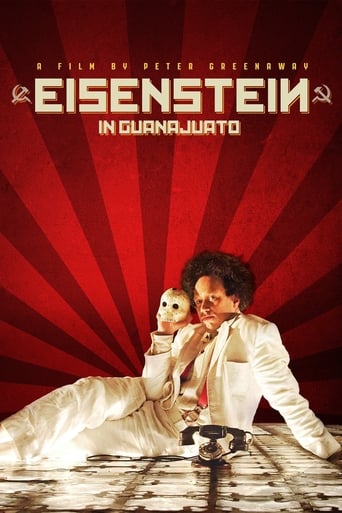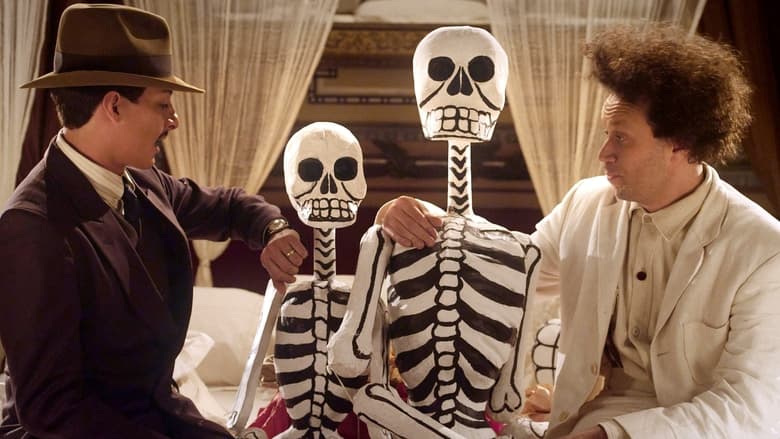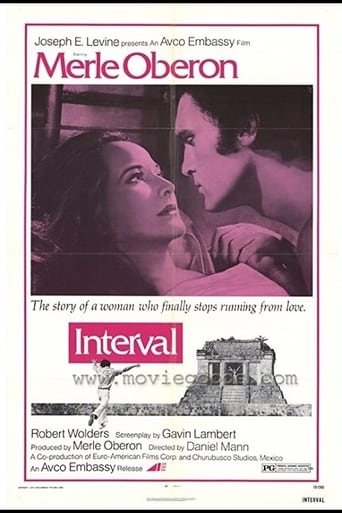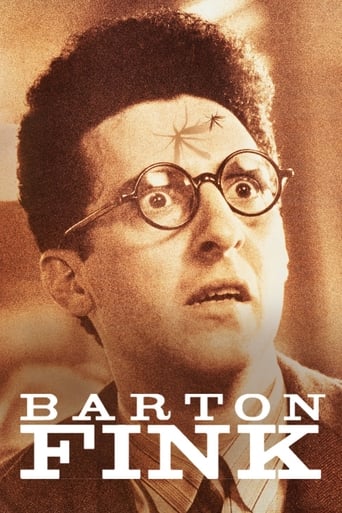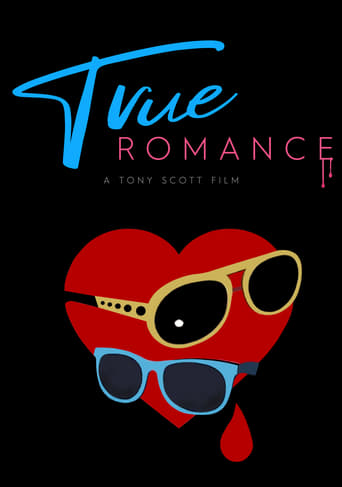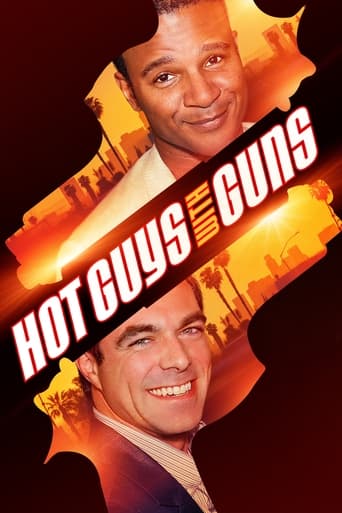Eisenstein in Guanajuato (2015)
In 1931, following the success of the film Battleship Potemkin, Soviet filmmaker Sergei Eisenstein travels to the city of Guanajuato, Mexico, to shoot a new film. Freshly rejected by Hollywood, Eisenstein soon falls under Mexico’s spell. Chaperoned by his guide Palomino Cañedo, the director opens up to his suppressed fears as he embraces a new world of sensual pleasures and possibilities that will shape the future of his art.
Watch Trailer
Cast


Similar titles
Reviews
the audience applauded
A different way of telling a story
In truth, there is barely enough story here to make a film.
It's a good bad... and worth a popcorn matinée. While it's easy to lament what could have been...
As the title indicates, this is a biopic inspired by the Mexican days of Soviet Union cinema vanguard Sergei Eisenstein (1898-1948), after his sortie into Hollywood proved to be futile, in 1930, he was assigned to make the ambitious but ultimately problematic project QUE VIVA MEXICO in Mexico (the whole ordeal is worthy of its own screen re-enactment), which Eisenstein would later relinquishes, a relatively intact version would only be released posthumously in 1979. No one would expect Peter Greenaway's treatment to be strictly reverent, although now in his seventies, Greenaway has no hesitation of venturing into the prurient facet of Eisenstein's idiosyncrasy and abandon, preponderantly, the film is a two-hander between Sergei (Bäck) and his Mexican guide Palomino Cañedo (Alberti), to whom Sergei claims to lose his virginity. Sergei's homosexual initiation is explicitly explored in the palatial hotel room he stays, on that vast bed, the sex temple he shares with Palomino, and coins the first ten days in Guanajuato as "Ten Days that shook Eisenstein", a wordplay to his revolutionary pièce-de-résistence OCTOBER: TEN DAYS THAT SHOOK THE WORLD (1928). Greenaway delights in magnifying Eisenstein's blunt self-reflection and directorial frustration (although it is mostly an interior piece that largely overlooks the filmmaker's onerous field work, excluding a visit to the Mummies of Guanajuato and the institution of the Day of the Dead celebration) through his larger-than-life approach which constitutes operatic ways of utterance, info-dumping sleight-of-hand where real-life footage is rapidly juxtaposed to counterpoint the references in a triptych split-screen, and majestic, but noticeably digitally airbrushed and light-inflected scenography, being put into great use in the flourishes of 360 degree twirling shots and seamlessly edited faux-long shots, etc., all is impressive on a grandiose scale, but also appreciably betrays an overreaching effort to reassure us that he is still at the top of his game.Under the spotlight is Finnish actor Elmer Bäck's madcap impersonation of a ludic, unprepossessing Eisenstein, sporting a fuzzy, bouffant hairdo à la Einstein, and gives his all to Greenaway's undue caprices, which on the whole leaves the impression that Eisenstein is more hysterical than sympathetic, a clownish figure whose brilliance is very much elusive to moderately stunned audience, a typical case of miscast should be noted. Luis Alberti, by comparison, comes off less scathed owing to his more natural and unaffected "stud" role in the play. By and large, Greenaway's self-reflexive, symphonically flamboyant opus can be construed as a nonconformist filmmaker's knowing salute to a free-spirited genius who constantly clashes with his times and whose legacy should be incessantly exhumed to meet new light and fresh air, and knock dead any number of spectators.
Elmer Back plays Eisenstein (where did they find this guy?). Back's performance is magnetic and mesmerizing, one of my favorites of the year. Back brings a wonderful sense of humor to the film and is an outstanding physical actor/comedian. His slight facial gestures and mannerisms bring a full depth of dimension to his portrayal of Sergei Eisenstein. His frenetic, manic energy with a resting heart rate of about 150 beats per minute is simply a wonder to watch and in perfect step with the film's visual explosiveness. Biopics (by the way this is a VERY loose biopic) are exceptionally easy to make bad, pretty easy to make mediocre, hard as s**t to make good and nearly impossible to make unique. So it comes as no surprise that it a truly formula shattering biopic covering one of the most wildly innovative, complex and enigmatic geniuses in the history of cinema (or in the world).It's the thirties and Soviet film pioneer and Stalinists propagandists Sergei Eisenstein has been shunned by Hollywood for his obvious Red connections and on taking advice by friends such as Charlie Chaplin has gone to Mexico to make his next great "Masterpiece!" Which is more than a struggle, for as the audience slowly finds out, largely in manic diatribes spouted by Eisenstein himself, the legendary auteur is in a highly confused and vulnerable state in his life: financially, politically, sexually, philosophically and artistically. The set pieces in Eisenstein explode in glorious color imposed in fine tuned geometric framing; the depth of staging creates a world within a world, making the sets in Guanajuato a place that existed yet never quite existed. Greenaway in homage to Eisenstein uses many of his techniques montage editing, curt shots, quick scenes that suddenly cut in about three seconds just as Eisenstein, Aleksandr Dovzhenko, Dziga Vertov or other similar montage formalists such as Abel Gance would have. The difference in Greenaway's adoption and mixing of his own techniques with those classic reverence styles is that he maintains continuity in style yet never grows too predictable with his camera and never falls into the deathtrap that is nauseating Tarantino-esque pastiche. Greenaway's use of wide-angle lenses and wonderful tracking dolly shots (reminiscent of Max Ophuls) to follow the frenzied, perpetually moving Eisenstein to-and-fro is amazing and never misses a beat. At certain points Greenaway splits the screen using classic clips of Eisenstein's films and photographs of people that are being referenced as Eisenstein speaks, putting on full display the classic stylings of classic art-cinema, all the while maintaining an air of freshness.Back's performance can become much too some, but in all of Eisenstein's rambling monologues one becomes aware of this man's inner feelings, his emotions that swing from one pole to the next, his true feelings about the Soviet Bear, his fears, his eccentricities, his hang-ups, his diva-bility, as well as his true genius. While the story may seem to remain a bit too vague for some, the devil is in the details. Greenaway is not the man that is going to do a traditional deep-sea delving into the life a character. In Eisenstein Greenaway methodically externalizes the director's philosophies on life and art (and the machinations behind art). We learn about Eisenstein through simple, seemingly unimportant instances (in terms of the man's work), like how he falls for his Mexican chaperone Palomino (Luis Alberti), who eventually anally deflowers Eisenstein in a very funny, touching, matter of fact scene that I assume made many audience members cringe uncomfortably. There are also a few striking scenes with skeletons and a skull; Eisenstein becoming truly enamored with all of this imagery that's semiotics recall the mystery and exotic pageantry of "The Day of the Dead." The Day of the Dead Eisenstein was very much interested in how the mind processed associations and I couldn't help but to think of the hopeless drunk Albert Finney played in John Huston's Mexico-set film Under the Volcano, where both Eisenstein and Finney's characters mirror each other in a particular way. Both are confused, wasting their talents, lost, lost in an existential sense and lost in a foreign place. Eisenstein in Guanajuato is crucially underrated. For fans of Eisenstein it is a must see and is still enjoyable for fans of film even if unaware of the great Sergei Eisenstein and early cinematic forms, though will certainly miss a lot.
Ordinarily I can take Peter Greenaway or leave him alone -- chiefly the latter. But he really scores this time with a story that has longed to be told.As is known Sergei Eisenstein hoped to work in Hollywood in the early thirties just as sound came in. But thanks to aright-wing campaign (plus its own lack of imagination) Paramount Pictures was scared off from making films of with of the scripts the great Russian director had written : an adaptation of Dreiser's "An American Tragedy" and an original historical drama "Sutter's Gold." The novelist Upton Sinclair stepped in and elected to back a film Eisenstein wanted to make about Mexico. But he knew nothing about film production and less about Eisenstein's highly improvisatory working methods. Under-budgeted and best by problems the shoot was brought to a halt when Sinclair's brother-in-law, Hunter Kimbrough discovered SME was having too much fun south of the border. Moreover he got a gander at the great man's cache of frankly gay pornographic drawings. Eisenstein not only never got to edit "Que Viva Mexico" -- he never even saw the rushes. He returned to Russia where he made "Alexander Nevsky" and "Ivam the Terrible" Sinclair meanwhile had the "Que Viva Mexico" footage sliced and diced into travelogues.This is the backdrop of what Greenaway has done which s to present Eisenstein's Mexican sojourn as a sexual awakening. He falls madly in love (and lust) with a handsome guide. Greenaway brings the full bore of his visual imagination to telling this tale with multiple images and lighting the likes of which hasn't been seen since Sternberg. Elmer Back is superb as SME and Luis Alberti is equally great as his love interest. Not to be missed.
EISENSTEIN IN GUANAJUATO is elder British auteur Greenaway's extravagant view of the famous Russian film pioneer he claims to admire immensely. The World Premiere presented at the 2015 Berlin Film Festival was an outrageously colorful ball buster, much better than expected after numerous previous Greenaway fiascos seen over the years ~ In fact, a glorious raucous Wakeup Call in the wake of a string of big name festival soporifics earlier in the week. The film bursts forth immediately with numerous three-way split screens bulging with highly informative and educational archival footage~~ almost too many messages to absorb at a single sitting.Most outrageous of all, we see the revered cinema Grandmaster Eisenstein presented In unabashed full frontal nude glory as a gloating Fag (extinct word for "gay") --receiving rectal penis injection from handsome Mexican producer and new found Latin lover (Luis Alberti) who introduces the austere Russian filmmaker to the pleasures of alternative sexual orientation. Presumably about Eisenstein's trip to Mexico in 1931 to make his legendary lost film which was later pieced together from existing fragments by others -- his grandiose epic collage "QUE VIVA MEJICO!". Finnish born Actor Elmer Bäck (b. 1981) is no dead ringer for the real Eisenstein but the wild wiry genius hairdo serves to identify the character. This is actually more about the fun he had there than the making of the famous movie -- thought to be lost for many years -- which is a story in itself. Just remember that Guanajuato is a city in Mexico, not to be confused with GUANTÀNAMO, the infamous CIA water-boarding school in Cuba. Bring along your Mexican jumping beans and an open mind. Not for every taste, but then -- What is? Eisenstein purists may consider all this an insult to his memory while others may see it as a loose tribute to be taken with a few grains of salt.It is well worth quoting the director's own view of the subject of his film: "The venerated filmmaker Eisenstein is comparable in talent, insight and wisdom, with the likes of Shakespeare or Beethoven; there are few - if any - directors who can be elevated to such heights. On the back of his revolutionary film Battleship Potemkin, he was celebrated around the world, and invited to the US. Ultimately rejected by Hollywood and maliciously maligned by conservative Americans, Eisenstein traveled to Mexico in 1931 to consider a film privately funded by American pro-Communist sympathizers, headed by the American writer Upton Sinclair. Eisenstein's sensual Mexican experience appears to have been pivotal in his life and film career - a significant hinge between the early successes of Strike, Battleship Potemkin, and October, which mad him a world-renowned figure, and his hesitant later career with Alexander Nevsky, Ivan the Terrible and The Boyar's Plot". Peter Greenaway Hmm -- xMakes one wonder about Greenaway's own orientation ...N'est-ce pas?

